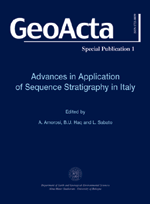GeoActa Special Publication 1
2008


Acquisto online |
GeoActa
an international Journal of Earth Sciences
|
|
Marco Brandano1-2, Giacomo Civitelli1-2
1Dipartimento di Scienze della Terra, Università di Roma "La Sapienza", Ple Aldo Moro 5, 00185 Roma, Italy. E-mail: marco.brandano@uniroma1.it
2CNR, Istituto di Geologia Ambientale e Geoingegneria, Sezione "La Sapienza" , 00185 Roma, Italy . E-mail: giacomo.civitelli@uniroma1.it
|
|
|
Sequence stratigraphy of the Latium-Abruzzi carbonate ramp (Miocene, Central Apennines, Italy)
|
|
|
|
|
|
|
|
PDF (3,0 MB)
|
Abstract
The Miocene carbonates of the Latium-Abruzzi carbonate platform domain (central Apennines) are known as “Calcari a Briozoi e Litotamni” Formation (CBL). Miocene carbonate strata unconformably overlie Cretaceous and, locally, Palaeogene platform limestones. The biota producing sediments belong to the rhodalgal and subordinately chlorozoan associations in the photic zone, molechfor and bryomol associations in the aphotic environments. The depositional profile obtained for the CBL is a homoclinal ramp. The profile is the result both from the inherited substratum (the Cretaceous carbonate platform) and from the locus of carbonate production and accumulation. The ramp can be divided into three depositional environments: inner ramp, middle ramp and outer ramp. The inner ramp is characterized, by a high-energy environment immediately below the littoral zone. The biota associations (barnacles, red algae, epiphytic and larger foraminifera) and the ichnogenera assemblages (Gaestrochaenolites, Caulostrepsis) indicate that the inner-ramp carbonate production took place in the euphotic zone. In the middle ramp the main carbonate producers are larger foraminifera and red algae, with subordinate echinoids, bryozoans and bivalves. Based on biota associations, the middle ramp should be located in the oligophotic zone. The outer ramp can be subdivided into proximal, intermediate and distal outer ramp. In the proximal outer ramp the main sediment-producing biota are represented by bryozoan colonies, bivalves (pectinids and oysters) and echinoids. The scattered rhodolith levels and the absence of larger foraminifera suggest a depositional environment at the transition from the oligophotic to the aphotic zone. The intermediate outer-ramp lithofacies are dominated by benthonic and planktonic foraminifera, echinoids and bivalve fragments. In the distal outer ramp the biota assemblage is mainly characterised by planktonic foraminifera and silica sponge spicules, with subordinate bryozoans and echinoids fragments. Based on biota assemblages the outer ramp, from the intermediate to the distal zone, is placed in the aphotic zone.
The age of CBL Formation was determined by detailed biostratigraphy integrated with strontium isotope stratigraphy . The facies architecture of the upper Aquitanian to Tortonian deposits reflect two large-scale, long-term, sequences.
The lower sequence (LD), Aquitanian to Serravallian in age, contains an upper lowstand systems tract, a transgressive systems tract, and a highstand systems tract. The lower part of the lowstand systems tract is preserved only in the basinal area, whereas all three main facies belts of the ramp (inner, middle and outer ramp) are preserved in the upper lowstand systems tract. In the transgressive systems tract only the middle and outer ramp deposits are preserved; the middle ramp facies stepped back as a consequence of the landward (upward) migration of the photic carbonate-producing biota. At the same time the proximal outer-ramp facies, dominated by bryomol skeletons carbonate production, stepped back but prograde also. The bryomol carbonate factory being independent of water depth, was able to keep producing sediment even in conditions of progressive deepening. The highstand systems tract is characterised by a reduction of the proximal outer-ramp lithofacies, concurrently with the lateral expansion of middle-ramp and intermediate outer-ramp lithofacies. During this phase a change in facies orientation is recorded with the shallower facies limited to the more eastern zones of the Latium-Abruzzi domain and deepening toward west. The upper sequence (US) is Serravallian-early Tortonian in age. It consists of a lowstand systems tract only and is terminated by the tectonically-driven, forced, drowning phase controlled by the eastward migration of the flexure of the Apenninic foredeep system. The termination of this sequence is expressed by a drowning phase which brings hemipelagic sediments first and siliciclastic turbidites, later, in response to the eastward migration of the Apenninic foredeep. The higher frequency is recorded in the inner-ramp succession, during the lowstand phase of the SD1.
The peculiarity of the Latium-Abruzzi carbonate ramp is represented by the response of the bryomol carbonated factories to the main transgressive phase. This factory, being independent of water depth, was able to continue production even in conditions of progressive deepening. The progressive expansion of this facies belt is related to the trophic conditions of sea-water.
Keywords: Carbonate ramp, Sequence stratigraphy, Miocene, Foramol carbonates, Sea-level change.
|
|
|


